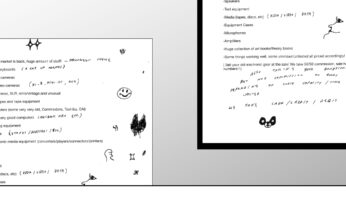Moving Forward: What Came From Our Visioning and Where Do We Go From Here
Dear CFAT Membership and Community,
A few weeks ago CFAT held a gathering inviting members and interested community to discuss how our centre can be of better service to artists (and those who want to be artists) working with digital and electronic technologies. This gathering helped give CFAT a clearer picture of how our communities understand the centre’s value and where the centre should prioritize its efforts to be of even greater relevance and service.
The following information is a summary of key themes that came from the discussions throughout the evening. This input is critical for assuring that those of us working on behalf of our members as board and staff are steering the organization in a way that reflects and is worthy of the artists we serve.
To those who were able to join us for the meeting, we are grateful for your generosity of time and spirit and we thank you for your help.
Couldn’t make the meeting? Want to give your thoughts? It’s not too late to contribute. Feel free to contact the CFAT board of directors directly (board@cfat.ca) or complete this brief survey (https://tinyurl.com/h7x6quy).
In the coming months, CFAT will use this input as a lens through which we will re-articulate our organization’s mission and goals. Please keep in touch and look out for more information on how else you can be involved!
Becka Barker
Chair, Board of Directors
Theme 1: Membership, Access, and Community
- What does it mean to belong or be ‘of’ the centre? Should a fee constitute membership? If not, what should?
- Membership fees are a barrier to economically-marginalized artists (ie most of us).
- CFAT dollars are great for offsetting equipment rental expenses, but can’t be used for membership.
- More transparency/feedback loops for membership are needed to ensure will, direction, and activities undertaken by the centre reflect what members want and need.
- Members need to feel they have ownership of the organization.
- Membership needs to be more diverse and inclusive; membership and interested community identify the membership fee itself as an economic barrier to participation in the organization.
- How can we be a group and a space that makes media artists want to get together, share their work, and support each other? Can we improve the space we’re in? What are our priorities for physical space?
- How can we better connect artists to funding opportunities that support the creation and dissemination of their work?
Theme 2: Representation and Diversity
- There was widespread acknowledgement by all present that CFAT must prioritize needs of historically-marginalized and -racialized artists, as we are missing out on stories, voices, and points of view that push, challenge, and help shape our understanding of art and the world.
- Many articulated the concern of tokenism and thinking of this particular issue in terms that are accidentally exclusionary (i.e. framing this ‘issue’ only as outreach, or in terms of special programs).
- The reason for increasing participation by artists who are racialized and/or otherwise marginalized should be to promote a broader array of stories, voices, and perspectives still missing from much of local contemporary art and the arts in general.
- People of colour seeing themselves in stories/ideas explored by artists of colour is crucial to eventually normalizing such diversity.
- The need for inclusion of racialized and other marginalized artists at CFAT must exist in all aspects of the organization: from governance, to staff, to membership activity, to participation in programming and production support/professional development programs.
Theme 3: Employment Fairness/Respect for Artists and Cultural Workers
- Staff employed at CFAT need to be paid a living wage.
- Artists’ work and art-related contributions outside of their studio practices (such as participation on juries) should be compensated, as it negatively impacts the artist’s ability to make a living otherwise.
- That artist-run centre staff positions are normalized as ‘burn-out’ jobs (ie extremely high responsibility and highly-specialized expertise for very low wages) is problematic and needs to change.
- Ensuring adequate support for staff to ensure a healthy and equitable working environment should be a priority.
Theme 4: Organizational Transparency and Funding
- CFAT must strive for excellence not only in the artwork whose production and dissemination we support, but also excellence in organizational practices and policies.
- CFAT should increase its organizational transparency at all levels (board, staff, committees, etc.) and improve communication with community.
- CFAT needs to work toward becoming a more sustainable organization in terms of how it allocates its funds toward programs and projects, and it should become more open to unorthodox funding sources (such as crowdfunding).
- CFAT needs to investigate anti-oppression and decolonization as positions to help us critique how the very manner of its existence might inadvertently contribute toward oppression rather than equitable access.
- There was significant hope that Canada Council’s new funding model will give us an opportunity to reconsider our organizational structure.
Collaborations and Community Involvement
- Artistic production through CFAT would benefit from collaborations with disciplines outside of CFAT’s usual ‘comfort zone’; increasing porosity (or even total dissolution!) of disciplinary distinctions with respect to media arts.
- Partnerships CFAT establishes should be ones that help the organization grow and lessen organizational burdens for both parties.
- Keeping relationships with ‘sister’ organizations healthy will strengthen our community.
- CFAT has been sought out to help support the development and growth of media arts spaces for/with emerging projects, festivals, and groups. How can we best support such growth? What should CFAT’s role be when it comes to offering indirect support?






